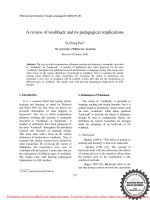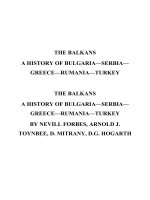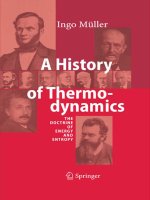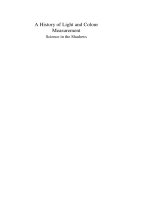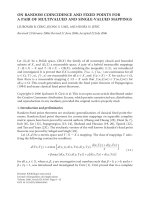Muller A History of Thermodynamics The Doctrine of Energy and Entropy phần 1 pot
Bạn đang xem bản rút gọn của tài liệu. Xem và tải ngay bản đầy đủ của tài liệu tại đây (1.29 MB, 32 trang )
A History of Thermodynamics
Ingo Müller
A History
of Thermodynamics
The Doctrine of Energy and Entropy
ABC
Professor Dr. Dr.h.c. Ingo Müller
Thermodynamik
Technische Universität Berlin
10623 Berlin
Germany
E-mail:
Library of Congress Control Number: 2006933419
ISBN-10 3-540-46226-0 Springer Berlin Heidelberg New York
ISBN-13 978-3-540-46226-2 Springer Berlin Heidelberg New York
This work is subject to copyright. All rights are reserved, whether the whole or part of the material is
concerned, specifically the rights of translation, reprinting, reuse of illustrations, recitation, broadcasting,
reproduction on microfilm or in any other way, and storage in data banks. Duplication of this publication
or parts thereof is permitted only under the provisions of the German Copyright Law of September 9,
1965, in its current version, and permission for use must always be obtained from Springer. Violations are
liable for prosecution under the German Copyright Law.
Springer is a part of Springer Science+Business Media
springer.com
c
Springer-Verlag Berlin Heidelberg 2007
The use of general descriptive names, registered names, trademarks, etc. in this publication does not imply,
even in the absence of a specific statement, that such names are exempt from the relevant protective laws
and regulations and therefore free for general use.
Typesetting: by the author and techbooks using a Springer L
A
T
E
X macro package
Cover design: design & production GmbH, Heidelberg
Printed on acid-free paper SPIN: 11553786 89/techbooks 543210
Preface
The most exciting and significant episode of scientific progress is the
development of thermodynamics and electrodynamics in the 19th century
and early 20th century. The nature of heat and temperature was recognized,
the conservation of energy was discovered, and the realization that mass
and energy are equivalent provided a new fuel, – and unlimited power.
Much of this occurred in unison with the rapid technological advance
provided by the steam engine, the electric motor, internal combustion
engines, refrigeration and the rectification processes of the chemical
industry. The availability of cheap power and cheap fuel has had its impact
on society: Populations grew, the standard of living increased, the environ-
ment became clean, traffic became easy, and life expectancy was raised.
Knowledge fairly exploded. The western countries, where all this happened,
gained in power and influence, and western culture – scientific culture –
spread across the globe, and is still spreading.
At the same time, thermodynamics recognized the stochastic and
probabilistic aspect of natural processes. It turned out that the doctrine of
energy and entropy rules the world; the first ingredient – energy – is
deterministic, as it were, and the second – entropy – favours randomness.
Both tendencies compete, and they find the precarious balance needed for
stability and change alike.
Philosophy, – traditional philosophy – could not keep up with the grand
words and subjective thinking – in the conventional style –, and scientific
culture, which uses mathematics and achieves tangible results.
Indeed, the concepts of the scientific culture are most precisely expressed
mathematically, and that circumstance makes them accessible to only a
minority: Those who do not shy away from mathematics. The fact has
forced me into a two-tiered presentation. One tier is narrative and largely
devoid of formulae, the other one is mathematical and mostly relegated to
Inserts. And while I do not recommend to skip over the inserts, I do believe
that that is possible – at least for a first reading. In that way a person may
ficance. The word came up about two cultures: One, which is mostly loose
expansion of knowledge. It gave up and let itself be pushed into insigni-
acquire a quick appreciation of the exciting concepts and the colourful
personages to whom we owe our prosperity and – in all probability – our
lives.
Berlin, Ingo Müller
July 2006
Contents
1 Temperature 1
2 Energy 9
Caloric Theory 9
Benjamin Thompson, Graf von Rumford 10
Robert Julius Mayer 13
James Prescott Joule 21
Hermann Ludwig Ferdinand (von) Helmholtz 24
Electro-magnetic Energy 29
Albert Einstein 35
Lorentz Transformation 37
E = m c
2
40
Annus Mirabilis 43
3 Entropy 47
Heat Engines 47
Nicolas Léonard Sadi Carnot 52
Benoît Pierre mile Clapeyron 55
William Thomson, Lord Kelvin 57
Rudolf Julius Emmanuel Clausius 59
Second law of Thermodynamics 65
Exploitation of the Second Law 68
Terroristic Nimbus of Entropy and Second Law 72
Modern Version of Zero
th
, First and Second Laws 73
What is Entropy? 77
4 Entropy as S = k ln W 79
Renaissance of the Atom in Chemistry 80
Elementary Kinetic Theory of Gases 82
James Clerk Maxwell 87
The Boltzmann Factor. Equipartition 92
Ludwig Eduard Boltzmann 94
É
VIII Contents
Reversibility and Recurrence 103
Maxwell Demon 107
Boltzmann and Philosophy 108
Kinetic Theory of Rubber 111
Gibbs´s Statistical Mechanics 117
Other Extrapolations. Information 123
5 Chemical Potentials 127
Josiah Willard Gibbs 128
Entropy of Mixing. Gibbs Paradox 129
Homogeneity of Gibbs Free Energy for a Single Body 131
Gibbs Phase Rule 133
Law of Mass Action 134
Semi-permeable Membranes 136
On Definition and Measurement of Chemical Potentials 137
Osmosis 139
Raoult´s Law 142
Alternatives of the Growth of Entropy 146
Entropy and Energy in Competition 148
Phase Diagrams 149
Law of Mass Action for Ideal Mixtures 152
Fritz Haber 156
Socio-thermodynamics 159
6 Third law of Thermodynamics 165
Capitulation of Entropy 165
Inaccessibility of Absolute Zero 167
Diamond and Graphite 168
Hermann Walter Nernst 170
Liquifying Gases 172
Johannes Diderik Van Der Waals 176
Helium 182
Adiabatic Demagnetisation 185
He
3
-He
4
Cryostats 186
Entropy of Ideal Gases 187
Classical Limit 191
Full Degeneration and Bose-Einstein Condensation 192
Satyendra Nath Bose 194
Bosons and Fermions. Transition probabilities 195
7 Radiation Thermodynamics 197
Black Bodies and Cavity Radiation 198
Violet Catastrophy 201
Contents IX
Planck Distribution 204
Energy Quanta 207
Max Karl Ernst Ludwig Planck 209
Photoelectric Effect and Light Quanta 211
Radiation and Atoms 212
Photons, a New Name for Light Quanta 214
Photon Gas 216
Convective Equilibrium 222
Arthur Stanley Eddington 227
8 Thermodynamics of Irreversible Processes 233
Phenomenological Equations 233
9 Fluctuations 273
Brownian Motion 273
Brownian Motion as a Stochastic Process 275
Mean Regression of Fluctuations 279
Auto-correlation Function 281
Extrapolation of Onsager´s Hypothesis 282
Light Scattering 282
More Information About Light Scattering 286
10 Relativistic Thermodynamics 289
Ferencz Jüttner 289
White Dwarfs 293
Subramanyan Chandrasekhar 296
Maximum Characteristic Speed 299
● Jean Baptiste Joseph Fourier………………………………… 233
● Adolf Fick…………………………………………………… 237
● George Gabriel Stokes…………………………………………239
Carl Eckart………………………………………………………. 242
Onsager Relations……………………………………………… 248
Rational Thermodynamics………………………………………. 250
Extended Thermodynamics………………………………………255
●
Formal Structure……………………………………………….255
● Symmetric Hyperbolic Systems ……………………………….256
● Growth and Decay of Waves………………………………… 258
●
Carlo Cattaneo …………………………………………………261
●
Shock Waves ………………………………………………… 267
● Boundary Conditions………………………………………… 268
● Characteristic Speeds in Monatomic Gases……………………259
● Field Equations for Moments………………………………… 265
11 Metabolism 307
Carbon Cycle 308
Respiratory Quotient 309
Metabolic Rates 312
Digestive Catabolism 313
Tissue Respiration 315
Anabolism 316
On Thermodynamics of Metabolism 319
What is Life? 320
Boltzmann-Chernikov Equation 300
Ott-Planck Imbroglio 303
X Contents
Index 325
1 Temperature
Temperature – also temperament in the early days – measures hot and cold
and the word is, of course, Latin in origin: temperare - to mix. It was mostly
used when liquids are mixed which cannot afterwards be separated, like
wine and water. The passive voice is employed – the ‘‘-tur” of the present
tense, third person singular – which indicates that some liquid is being
mixed with another one.
For Hippokrates (460–370
B.C.), the eminent, half legendary Greek physi-
cian, proper mixing was important: An imbalance of the bodily fluids
blood, phlegm, and black and yellow bile was supposed to lead to disease
which made the body unusually hot or cold or dry or moist.
Klaudios Galenos (133–200
A.C.), vulgarly Galen, – another illustrious
Greek physician, admirer of Hippokrates and polygraph on medical
matters – took up the idea and elaborated on it. He assumed an influence of
the climate on the mix of body fluids which would then determine the
character, or temperament (sic), of a person. Thus body and soul of the
inhabitants of the cold and wet north were wild and savage, while those of
the people in the hot and dry south were meek and flaccid. And it was only
in the well-mixed – temperate – zone that people lived with superior
properties in regard to good judgement and intellect,
1
the Greeks naturally
and, perhaps, the Romans.
Galen mixed equal amounts if ice and boiling water, which he considered
the coldest and hottest bodies available. He called the mixture neutral,
2
and
installed four degrees of cold below that neutral point, and four degrees of
hot above it. That rough scale of nine degrees survived the dark age of
science under the care of Arabian physicians, and it re-emerged in Europe
during the time of the Renaissance.
book ‘‘De logistica medica”, he presented an elaborate table of body
temperatures of people in relation to the latitude under which they live, cf.
Fig. 1.1. Dwellers of the tropics were warm to the fourth degree while the
1
Galen: ‘‘Daß die Vermögen der Seele eine Folge der Mischungen des Körpers sind.” [That
the faculties of the soul follow from the composition of the body] Abhandlungen zur
2
It is not clear whether Galen mixed equal amounts by mass or volume; he does not say. In
the first case his neutral temperature is 10°C in the latter it is 14°C; neither one is of any
obvious relevance to medicine.
Thus in the year 1578, when Johannis Hasler from Berne published his
(1977).
Geschichte der Medizin und Naturwissenschaften. Heft 21. Kraus Reprint Liechtenstein
2 1 Temperature
eskimos were cold to the fourth degree. Persons between latitudes 40° and
50°, where Hasler lived, were neither hot nor cold; they were given the
neutral temperature zero.
One must admit that the idea has a certain plausibility and, indeed, the
nine degrees of temperature fit in neatly with the 90 degrees of latitude
between the equator and the pole. However, it was all quite wrong: All
healthy human beings have the same body temperature, irrespective of
where they live. That fact became soon established after the invention of the
Fig . 1.1. Hasler’s table of body temperatures in relation to latitude
The instrument was developed in the early part of the 17th century. The
development is painstakingly researched and well-described – as much as it
can be done – by W.E. Knowles Middleton in his book on the history of the
thermometer.
3
Another excellent review may be found in a booklet by
Ya.A. Smorodinsky.
4
It is not clear who invented the instrument. Middleton
complains that questions of priority are loaded with embarrassment for the
historian of science…, and he indicates that the answers are often biased by
nationalistic instincts.
3
W.E. Knowles Middleton: ‘‘The History of the Thermometer and its Use in Meteorology”.
The Johns Hopkins Press, Baltimore, Maryland (1966).
Hasler table of body temperatures, cf. Fig.1.1, is the frontispiece of that book.
4
Ya.A. Smorodinsky: “Temperature”. MIR Publishers, Moscow (1984).
thermometer.
1 Temperature 3
So also in the case of the thermometer: According to Middleton there
was some inconclusive bickering about priority across the Alps, between
England and Italy. One thing is certain though: The eminent scientist
Galileo Galilei (1564–1642) categorically claimed the priority for himself.
And his pupil, the Venetian diplomat Gianfrancesco Sagredo accepted that
claim after at first being unaware of it. Sagredo experimented with the
thermometer and on May 9th, 1613 he wrote to the master
5
:
The instrument for measuring heat, invented by your excellent self …[has
shown me] various marvellous things, as, for example, that in winter the
air may be colder than ice or snow; …
Another quaint observation on well-water is communicated by Sagredo
to Galilei on February 7th, 1615, cf. Fig. 1.2
6
. It is clear what Sagredo
means: If you bring water up in summer from a deep well and you stick
your hand into it, it feels cool, while, if you do that in wintertime, the water
feels warm.
in Firenze
Venezia, 7 febbraio 1615
Molto Ill.
re S.r Ecc.mo
… Con questi istrumenti ho chiaramente veduto,
esser molto più freda l’aqua de’ nostri pozzi il
verno che l’estate; e per me credo che l’istesso
avenga delle fontane vive et luochi soteranei,
anchorchè il senso nostro giudichi diversamente.
Et per fine li baccio la mano
In Venetia, a 7 Febraro 1615
Di V.S. Ecc.
ma
Tutto suo Il Sag.
Fig. 1.2. Galileo Galilei. A cut from a letter of Sagredo to Galilei with the remarkable
sentence: I have clearly seen that well-water is colder in winter than in summer …, although
Misconceptions due to the subjective feeling of hot and cold were slowly
eliminated during the course of the 17th century. A serious obstacle was
that no two thermometers were quite alike so that, even when there were
5
Middleton. loc.cit. p. 7.
6
“Le Opere di Galileo Galilei”, Vol. XII, Firenze, Tipografia di G. Barbera (1902) p.139.
The letter, and other letters by Sagredo to Galilei are replete with flattering, even syco-
phantic remarks which the older man seems to have appreciated. Part of that may be
attributed, perhaps, to the etiquette of the time. But, in fact, it may generally be observed –
even in our time – that, the more eminent a scientist already is, the more he demands
praise; and a diplomat knows that.
our senses tell differently
GIOVANFRANCESCO SAGREDO a GALILEO
4 1 Temperature
scales on them, it was difficult to communicate objective information from
one place to another.
Scales were just as likely to run upwards as downwards at that time.
Middleton
7
lists the scale on a surviving thermometer built by John Patrick
in or around the year 1700; it runs downward with increasing heat from 90°
90° Extream Cold 55° Cold Air 15° Sultry
85° Great Frost 45° Temperate Air 5° Very Hott
75° Hard Frost 35° Warm Air 0° Extream Hott
65° Frost 25° Hott
Fix-points were needed to make readings on different thermometers com-
parable. From the beginning, melting ice played a certain role – either in
water or in a water-salt-solution – and boiling water, of course. But alter-
natives were also proposed:
the temperature of melting butter,
the temperature in the cellar of the Paris observatory,
the temperature in the armpit of a healthy man.
The surviving Celsius scale uses melting ice and boiling water, and one
hundred equal steps in-between. However, since Anders Celsius (1701–
1744) wished to avoid negative numbers, he set the boiling water to 0°C
and melting ice to 100°C, – for a pressure of 1atm. Thus he too counted
downwards. That order was reversed after Celsius’s death, and it is in that
inverted form that we now know the Celsius scale, or centigrade scale.
Gabriel Daniel Fahrenheit (1686–1736) somehow thought that three fix-
points were better than two. He picked
a freezing mixture of water and sea-salt (0°F),
melting ice in water alone (32°F),
human body temperature (96°F).
Later he adjusted that scale slightly, so as to have boiling water at 212°F,
exactly 180 degrees above melting ice. One cannot help thinking that 180°
is a neat number, at least when the degrees are degrees of arc. However
Middleton, who describes the development of the Fahrenheit scale in some
detail, does not mention that analogy so that it is probably fortuitous.
Anyway, after the readjustment, the body temperature came to 98.6°F. That
is where the body temperature stands today in those countries, where the
Fahrenheit scale is still in use, notably in the United States of America.
From the above it is easy to calculate the transition formula between the
Celsius and the Fahrenheit scales: C = 5/9(F – 32).
7
Middleton: loc.cit. p. 61.
to 0°, thus maintaining remnants of Galen’s scale of 9 degrees, perhaps.
1 Temperature 5
There were numerous other scales, advertised at different times, in
different places, and by different people. It was not uncommon in the 18th
and early 19th century to place the thermometric tube in front of a wide
board with several different scales, – up to eighteen of them. Middleton
8
exhibits a list of scales shown on a thermometer of 1841:
Old Florentine Delisle Amontons
New Florentine Fahrenheit Newton
Hales Réaumur Société Royale
Fowler Bellani De la Hire
Paris Christin Edinburg
H. M.Poleni Michaelly Cruquius
All of these scales were arbitrary and entirely subjective but, of course,
perfectly usable, if only people could have agreed to use one of them, –
which they could not.
A new objective aspect appeared in the field with the idea that there
might be a lowest temperature, an absolute minimum. By the mid-
nineteenth century, two hundred years of experimental research on ideal
gases had jelled into the result that the pressure p and the volume V of gases
were linear functions of the Celsius temperature (say), such that
m is the mass of the gas.
9
Therefore, upon lowering the temperature to
t = – 273.15°C at constant p, the volume had to decrease and eventually
vanish, and surely further cooling was then absurd. At first people were
unimpressed and unconvinced of the minimal temperature. After all, even
then they suspected that all gases turn into liquids and solids at low tempe-
ratures, and the argument did not apply to either.
However, in the 19th century it was slowly – painfully slowly –
recognized that matter consisted of atoms and molecules, and that
temperature was a measure for the mean kinetic energy of those particles.
This notion afforded an understanding of the minimal temperature, because
8
Middleton: loc.cit. p. 66.
9
In much of the 19th century literature this equation is called the law of Mariotte and Gay-
Lussac. Nowadays we call it the thermal equation of state for an ideal gas. The pioneers
of the equation were Robert Boyle (1627–1691), Edmé Mariotte (1620–1684), Guillaume
Amontons (1663–1705), Jacques Alexandre César Charles (1746–1823), and Joseph Louis
courses. Therefore I skip over its motivation and derivation. I only emphasize that the
value 273.15 is the same for all gases. That value was established by Gay-Lussac when
he measured the relative volume expansion by heating a gas of 0°C by 1°C. [The value
273.15 is the modern one; in fact it is 273.15
r 0.02. Gay-Lussac and others at the time
were up to 5% off.] [The factor k/µ is also modern. k is the Boltzmann constant and µ is
the molecular mass. Both are quite anachronistic in the present context. However, I wish
(273.15 C )
k
pV m t
µ
Gay-Lussac (1778–1850). Their work is now a favourite subject of high-school physics
to avoid the ideal gas constant and the molar mass in this book.]
6 1 Temperature
when temperature dropped, so did the kinetic energy of the particles – of
gases, liquids, and solids – and finally, when all were at rest, there was no
way to lower the temperature further.
Therefore William Thomson (1824–1907) (Lord Kelvin since 1892)
suggested – in 1848 – to call the lowest temperature absolute zero, and to
move upward from that point by the steps or degrees of Celsius. This new
scale became known as the absolute scale or Kelvin scale, on which melting
ice and boiling water at 1atm have the temperature values 273.15°K and
373.15°K respectively. K stands for Kelvin. It became common practice to
denote temperature values on the Kelvin scale by T, so that we have
T =
273.15
C
t
ÈØ
ÉÙ
ÊÚ
°K .
Kelvin’s absolute scale was quickly adopted and it is now used by
scientists all over the world. However, the scale has subtly changed since its
melting ice and boiling water were abolished as fix-points. They were
replaced by a single fix-point:
T
tr
= 273.16°K for the triple point of water.
The triple point of water occurs when ice, liquid water and water vapour
can coexist; its pressure is p
tr
= 6.1mbar, and its temperature is t
tr
= 0.01°C
on the Celsius scale. The modern degree is defined by choosing 1°K as
T
tr
/273.16. This unit step on the Kelvin scale was internationally agreed on
in 1954 so as to coincide with the familiar 1°C. The 13th International
Conference on Measures and Weights of 1967/68 even robbed temperature
of its little decorative adornment ‘‘°” for degree. Ever since then we speak
and write of temperature values prosaically as so many ‘‘K” instead of
‘‘degrees K”, or ‘‘°K”.
10
The lowest temperatures reached in laboratories are a few µK – a few
millionth of one Kelvin –, the highest may be 10MK – ten million Kelvin –,
and we believe that the temperature in the centre of some stars are as high
as 100 million K, cf. Chaps. 6 and 7.
For the early researchers there was no need to define temperature. They
knew, or thought they knew, what temperature was when they stuck their
thermometer into well-water, or into the armpit of a healthy man. They
were unaware of the implicit assumption, – or considered it unimportant, or
self-evident – that the temperature of the thermometric substance, gas or
mercury, or alcohol, was equal to the temperature of the measured object.
10
Temperature measurements at extremely low temperatures are still a problem. The
interested reader is referred to the publication ‘‘Die SI-Basiseinheiten. Definition,
Entwicklung, Realisierung.’’ [The SI basic units. Definition, development and realization]
Physikalisch Technische Bundesanstalt, Braunschweig & Berlin (1997) p. 31–35.
introduction. In 1954, by international agreement the temperatures of
1 Temperature 7
This in fact is the defining property of temperature: That the temperature
field is continuous at the surface of the thermometer; hence temperature is
measurable. Axiomatists call this the zeroth law of thermodynamics
because, by the time when they recognized the need for a definition of
temperature, the first and second laws were already firmly labelled.
2 Energy
The word energy is a technical term invented by Thomas Young (1773–
1829) in 1807. Its origin is the Greek word ȑȞİȡȖİȚĮ which means efficacy
or effective force. Young used it as a convenient abbreviation for the sum of
kinetic energy and gravitational potential energy of a mass and the elastic
energy of a spring to which the mass may be attached. That sum is
conserved by Newton’s laws and Hooke’s law of elasticity, although the
individual contributions might change.
1
The term energy was not fully
accepted until the second half of the 19th century when it was extrapolated
away from mechanics to include the internal energy of thermodynamics and
the electro-magnetic energy. The first law of thermodynamics states that the
total sum is conserved: the sum of mechanical, thermodynamic, electro-
magnetic, and nuclear energies. We shall proceed to describe the difficult
birth of that idea.
Eventually – in the early 20th century – energy was recognized as having
mass, or being mass, in accord with Einstein’s formula E = mc
2
, where c is
the speed of light.
Caloric Theory
In the early days of thermodynamics nobody spoke of energy; it was either
heat or force. And nobody really knew what heat was. Francis Bacon
(1561–1626) mentions heat in his book “Novum Organum” and – true to his
conviction that the laws of science should be gleaned from a mass of
specific observations – he tabulated sources of heat such as: flame,
lightning, summer, will-o’-the-wisp, and aromatic herbs which produce the
feeling of warmth when digested.
2
A little later Pierre Gassendi (1592–1655), a convinced atomist, saw heat
and cold as distinct species of matter. The atoms of cold he considered as
tetrahedral, and when they penetrated a liquid that liquid would solidify, –
somehow.
1
The observation that mechanical energy is conserved is usually attributed to Gottfried
Wilhelm Leibniz (1646–1716), who pronounced it as a law in 1693.
2
Francis Bacon: “Novum Organum’’ (1620).
10 2 Energy
An important step away from such interesting notions was done by
Joseph Black (1728–1799). Black melted ice by gently heating it and
noticed that the temperature did not change. Thus he came to distinguish the
quantity of heat and its intensity, of which the latter was measured by
temperature. The former – absorbed by the ice in the process of melting –
he called latent heat, a term that has survived to this day.
The next step – unfortunately a step in the wrong direction – came from
Antoine Laurent Lavoisier (1743–1794), the pre-eminent chemist of the
18th century, sometimes called the father of modern chemistry. He insisted
on accurate measurement and therefore people say that he did for chemistry
what Galilei had done for physics one and a half century before. The true
nature of heat, however, was beyond Lavoisier’s powers of imagination and
so he listed heat – along with light – among the elements,
3
and considered it
a fluid which he called the caloric. Asimov
4
writes that … it was partly
because of his [Lavoisier’s] great influence that the caloric theory …
remained in existence in the minds of chemists for a half century. The idea
was that caloric would be liberated when chips were taken off a metal in a
lathe (say) and thus the material became hot.
Benjamin Thompson (1753–1814), Graf von Rumford
Benjamin Thompson, later Graf von Rumford – ennobled by the Bavarian
elector Karl Theodor – was first to seriously question the caloric theory.
Thompson was born in Woburn, Massachusetts to poor parents, just like
Benjamin Franklin (1706–1790), the other famous American scientist of the
18th century; their birthplaces are only two miles apart. Both, although
congenial as scientists, subscribed to different political views. Indeed,
Thompson supported the British in the war of independence; he spied for
them and even led a loyalist regiment, – a Tory regiment for American
patriots – the King’s American Dragoons
.
5
Perforce, after the colonials had won their independence, Thompson left
America and, by his intelligence and his captivating demeanour, he became
a man of the world, welcome in courts and scientific circles. He proved to
be an inventor of everything that needed inventing: a modern kitchen –
complete with sink, overhead cupboards and trash slot –, a drip coffee pot,
3
A.L. Lavoisier: “Elementary Treatise on Chemistry” (1789).
4
I. Asimov: “Biographical Encyclopedia of Science and Technology’’ Pan Reference
Books, London (1975).
5
Kenneth Roberts: ‘‘Oliver Wiswell.” Fawcett Publications, Greenwich, Connecticut.
(1940).
Benjamin Thompson (1753–1814), Graf von Rumford 11
and the damper for chimneys.
6
Also he was a gifted organizer of anything
that needed to be organized:
x The distribution of a cheap, nourishing and filling soup – the Rumford
soup
7
– for the poor people of Munich,
x the transplanting of fully grown trees into the English garden of the
elector of Bavaria,
x and a factory for military uniforms staffed by the beggars from the
streets of Munich.
The grateful elector made him a count: Graf von Rumford, see Fig. 2.1.
Rumford was a town in Massachusetts, where Thompson had lived; later it
was renamed Concord – now in New Hampshire; it was a hotbed of the
American revolution. Needless to say that the elector knew neither Rumford
nor Concord. Actually, one cannot help feeling that the two of them, the
elector and Thompson, may have had a good laugh together: The elector,
who had no jurisdiction over Rumford county and Thompson, – the new
Graf von Rumford – who could not show his face there without running the
risk of being tarred and feathered and made to ride a fence.
Fig. 2.1. Lavoisier and Thompson (Graf Rumford), both married to the same woman, – at
different times
Graf Rumford was put in charge of boring cannon barrels for the elector.
He noticed that blunt drills liberated more caloric than sharp-edged ones,
although no chips appeared. By letting the blunt drill grind away for some
length of time he could liberate more caloric than was known to be needed
to melt the whole barrel. Thus he came to the only possible conclusion that
the caloric theory was bunk and that
6
According to Varick Vanardy: ‘‘Gen. Benjamin Thompson, Count Rumford: Tinker,
Tailer, Soldier, Spy.” .
7
A variant of that soup was handed out in German prisons until well into the 20th century.
It was then known as ‘‘Rumfutsch’’. According to Ernst von Salomon: ‘‘Der Fagebogen”
[The Questionaire] Rowohlt Verlag Hamburg (1951).
12 2 Energy
…it was inconceivable to think anything else than that heat was just the
same as what was supplied to the metal as continually as heat was appearing
in it namely: motion.
8
Considering the jargon of the time that was a direct hit. Even fifty years
later Mayer could not express the 1st law more clearly than by saying:
motion is converted to heat, – and Mayer did still shy away from saying:
Heat is motion.
Rumford even made an attempt to give an idea of what was later called
the mechanical
equivalent of heat. His drill was operated by the work of
two horses – of which one would have been enough – turning a capstan-bar,
and Rumford notes that the heating of the barrel by the drill
equals that of nine big wax candles.
Actually, he became more concrete than that when he said that the total
weight of ice-water that could be heated to 180°F in 2 hours and 30 minutes
amounted to 26.58 pounds.
9
Joule fifty years later
10
used that measurement
to calculate Rumford’s equivalent of heat to 1034 foot-pounds.
11
For the
calculation Joule adopted Watt’s measurement of one horsepower, namely
33000 foot-pounds per minute.
It is probably too much to suppose that Rumford thought about
conservation of energy, but he did say this:
One would obtain more heat [than from the drill], if one burned the fodder
suspected those amounts of heat to be the same.
Rumford through his arrogance and the general unpleasantness of his
character – so the American author Asimov
12
– eventually outwore his
welcome in Bavaria. He went to England where he was admitted into the
Royal Society. He founded the Royal Institution, an institute which may be
regarded as the prototypical postgraduate school. Rumford engaged
Thomas Young and Humphry Davy as lecturers, who both became eminent
scientists in their own time. Jointly with Davy, Rumford continued his
8
Rumford: “An inquiry concerning the source of the heat which is excited by friction”.
Philosophical Transactions. Vol. XVIII, p. 286.
9
Rumford: loc.cit. p. 283.
10
J.P. Joule: “On the mechanical equivalent of heat”. Philosophical Transaction. (1850) p.
61ff.
11
This means that a weight of 1 pound dropped from a height of 1034 feet would be able to
heat 1 pound of water by 1°F. [Joule’s best value in 1850 is 772 foot-pounds, see below.]
12
I. Asimov: ‘‘Biographies….” loc.cit.
Americans do not like their countryman Graf Rumford because of his involvement in the
war of independence on the side of the loyalists. They scorn him and revile him, and
largely ignore him. This is punishment for a person who fought on the wrong side – the
side that lost. We must realize though that the American revolutionary war was as much a
civil war as it was a war against the British rule; and civil wars have a way of arousing
strong feelings and long-lasting hatred.
of the horses. Thus he gave the impression, perhaps, that he may have
Robert Julius Mayer (1814–1878) 13
experiments on heat: He carefully weighted water before and after freezing
and found the weight unchanged, although it had given off heat in the
process. Therefore he concluded that the caloric, if it existed, was
imponderable. This observation should have disqualified the caloric, but it
did not, not for another 40 year.
After England, Rumford went to Paris where, posthumously, he crossed
the path of Lavoisier, because he married the chemist’s widow. Asimov
writes
The marriage was unhappy. After four years they separated and Rumford
was so ungallant as to hint that she was so hard to get along with that
Lavoisier was lucky to have been guillotined
13
. However, it is quite
obvious that Rumford was no daisy himself.
Rumford’s insight into the nature of heat was largely ignored and the
caloric theory of heat prevailed until the 1840s. At that time, however, in
the short span of less than a decade three men independently – as far as one
can tell
14
– came up with the first law of thermodynamics in one way or
other. Basically this was the recognition that the gravitational potential
energy of a mass at some height, or the kinetic energy of a moving mass,
may be converted into heat by letting it hit the ground. The three men who
realized that fact in the 1840s were Mayer, Joule and Helmholtz. All three
of them are usually credited with the discovery. And although all three
devote part of their works to the discussion of the weightless caloric –
actually to its refutation – it is clear that that theory had run its course. Says
Mayer in his usual florid style: Let’s declare it, the great truth. There are
no immaterial materials.
Robert Julius Mayer (1814–1878)
Mayer was first and he went further than either of his competitors, because
he felt that energy generally was conserved. He included tidal waves in his
considerations and conceived of falling meteors as a possible source of
solar heat- and light-radiation. Nor did he stop at chemical energy, not even
chemical energy connected with life functions.
Mayer was born and lived most of his life in Heilbronn, a town in the
then kingdom of Württemberg. Württemberg was one of the several dozen
independent states within the loose German federation, whose rulers
13
Lavoisier was executed on May 8, 1794 because of his involvement in tax collection under
the ancien régime. On the eve of his execution he wrote a letter to his wife. The chemist
was being philosophical: “It is to be expected ” the letter reads ‘‘that the events in which I
am involved will spare me the inconvenience of old age.”
14
This is what is usually said. It is not entirely true, though. To be sure, it is likely that Joule
and Helmholtz were unaware of Mayer’s ideas, but Helmholtz was fully aware of Joule’s
measurements, he cites them, see below.
14 2 Energy
suppressed all activity to promote German unity. Unity, however, was
vociferously clamoured for by the idealistic students in their fraternities;
therefore fraternities were declared illegal. But in Tübingen, where Mayer
studied medicine, he and some friends were indiscreet enough to found a
new fraternity. He was arrested for that – and for attending a ball indecently
dressed – and relegated from the university for one year.
Mayer made good use of the enforced inactivity by continuing his
medical education in Munich and Paris and then took hire as a ship’s
physician – a Scheeps Heelmeester – on a Dutch merchantman for a round-
trip to Java. This left him a lot of free time since, in his words, on the high
seas people tend to be healthy. He learned about two important phenomena
which he lists in his diaries:
x The navigator told him that during a storm the ocean water becomes
warmer,
15
and
x while bleeding patients he observed that in the tropics venous blood is
similar in colour to arterial blood.
The first observation could be interpreted as motion of the water waves
being converted to heat and the second seemed to imply that the des-
oxidization of blood is slower when less heat must be produced to maintain
the body temperature.
The flash of insight, a kind of ecstatic vision, came to Mayer when his
ship rode at anchor off Surabaja taking on board a consignment of sugar.
Henceforth he was a changed man, a fanatic in the effort of spreading his
gospel. And he hurried back home in order to let the world know about his
discovery
16
.
The gospel, however, left something to be desired. At least nobody
wanted to hear it. Right after his return from Java Mayer rushed out a paper:
“Über die quantitative and qualitative Bestimmung der Kräfte.”
17
Actually
there was nothing quantitative in the paper and, moreover, it was totally and
completely obscure. There was hapless talk in hapless mathematical and
geometrical language which could not possibly mean anything to anybody.
The only saving grace is the sentence: Motion is converted to heat, which
Rumford had said 40 years before. The paper ends characteristically in one
of the hyperbolic statements which are so typical for Mayer’s style: In stars
the unsolvable task of explaining the continuous creation of force, i.e. the
15
This observation is also mentioned by J.P. Joule: ‘‘On the mechanical equivalent of
16
Later, in 1848, Mayer was involved in a political squabble and he was ridiculed publicly
as having travelled as far as East India without setting his foot on land. This, however,
seems to be untrue, if Mayer’s diary is to be believed. He did leave the ship for a short
excursion; cf. H. Schmolz, H. Weckbach: “Robert Mayer, sein Leben und Werk in
Dokumenten’’. Veröffentlichungen des Archivs der Stadt Heilbronn. Bd. 12. Verlag H.
Konrad (1964) p. 86.
17
“On the quantitative and qualitative determination of forces’’.
heat . Philosophical Transaction (1850) p. 61 ff.
’’
Robert Julius Mayer (1814–1878) 15
differentiation of 0 to MC – MC, is solved by nature; the fruit of this is the
most marvellous phenomenon of the material world, the eternal source of
light. And in unshared enthusiasm Mayer finishes the paper with the
hopeful words
Fortsetzung folgt = to be continued.
Well, Poggendorff, to whose “Annalen der Physik and Chemie” Mayer
had sent the paper on June 16th 1841, was unimpressed. Certainly and
understandably he did not want to encourage the author. Despite several
urgent reminders by Mayer – the first one on July 3rd 1841 (!) –
Poggendorff never acknowledged receipt, nor did he publish the paper.
18
He must have thought of Mayer as of some queer physician in Heilbronn
with an unrequited love of physics.
Mayer had started a practice in Heilbronn, and in May 1841 he was
appointed town surgeon which gained him a regular salary of 150 florin.
Later he changed to Stadtarzt, at the same salary, and in that capacity he
had to treat the poor, – free of charge – and also the lower employees of the
town, like the prison ward or the night watchman.
19
Mayer’s problem in physics was that he did not know mechanics. He
took private instruction from his friend Carl Baur who was a professor of
mathematics at the Technical High-School Stuttgart, but Mayer never
graduated to the knowledge that the gravitational potential energy mgH of a
mass m at height H is converted to the kinetic energy
2
2
m
when the mass
falls and acquires the velocity
; specifically the factor ½ remained a
mystery for him. To be sure, he never used the word energy in the above
sense: gravitational potential energy was falling force for him and kinetic
energy was life force.
20
All he knew was, that motion, or the life force of motion could be
converted into heat and he even came up with a reasonable number: the
mechanical equivalent of heat, cf. Insert 2.1.
365 m
1 heat 1
g
ram at hei
g
ht
1130 Parisian feet
ÎÞ
Ïß
Ðà
.
18
The manuscript did survive and, when Mayer’s work was eventually recognized, the paper
was published in journals and books on the history of science, e.g. P. Buck (ed):
“Robert Mayer – Dokumente zur Begriffsbildung des Mechanischen Äquivalents der
Wärme’’. [Robert Mayer – documents on the emergence of concepts concerning the
Salzdetfurth (1980) Bd. 1, p. 20–26.
19
H. Schmolz, H. Weckbach: “Robert Mayer ” loc.cit p. 66, p. 78.
20
The life force must not be confused with the vis viva of the vitalists. In German the kinetic
energy was called lebendige Kraft at that time, while the vis viva was called Lebenskraft.
In English the distinction is not so clear and sometimes not strictly maintained, although
usually the context clarifies the meaning.
mechanical equivalent of heat] Reprinta historica didactica. Verlag B. Franzbecker, Bad
16 2 Energy
Mayer’s calculation of the mechanical equivalent of heat
Mayer knew – or thought he knew – that the specific heats of air are
gK
cal
267.0 and
gK
cal
421.1
267.0
at constant pressure and volume respectively. To heat 1 cm
3
air at a
density of 1.3 10
-3
g/cm
3
by 1°C it should therefore take
0.347 10
–3
cal at fixed pressure, and
0.244 10
–3
cal at fixed volume.
At constant pressure the volume expands. The difference in heat is 1.03 10
-4
cal and
that difference can lift a 76 cm tube of mercury of mass 1033g which exerts a
pressure of 1 atm. At 1°C the lift amounts to
1
274
cm according to Mariotte’s law,
which nowadays we call the thermal equation of state of ideal gases, like air. Thus
now it is a simple problem of the rule of three:
1033 g at 1/274cm corresponds to 1.03 10
-4
cal
It follows that H = 365 m and so Mayer wrote:
1° heat = 1 g at 365 m height
Note that Mayer did not measure anything. He took his specific heat from some
French experimentalists whom he quotes as Delaroche and Bérard. And the ratio of
specific heats he took from Dulong. Both numbers are slightly off and therefore
Mayer’s mechanical equivalent of heat was low.
Insert 2.1
In words: The fall of a weight from a height of ca. 365 m corresponds to
the heating of the same weight of water from 0°C to 1°C. Later, with
reference to Joule’s better measurements, he changed to 425 m or 1308
Parisian feet. The old value – but not its calculation – is included in
Mayer’s second paper, see Fig. 2.2, which otherwise is not much clearer
than the first one. Anyway that paper established Mayer’s priority when
Justus von Liebig (1803–1873) published it in his “Annalen der Chemie
und Pharmacie”. To be sure, Mayer did not give Liebig much of a choice;
his accompanying letter would have flattered any hard-nosed editor into
acceptance, cf. Fig. 2.3. Those readers who have a command of German
may learn from the letter how editors should be approached.
There is a peculiar type of reasoning in the paper. Mayer, rather than just
postulate the conversion of motion to heat and make it plausible, attempts to
prove his discovery from some perceived theorem of logical cause or from
an assumed axiom causa aequat effectum. On another occasion, the
conservation of energy – force for Mayer – is summarized in the slogan
Ex nihilo nil fit. Nil fit ad nihilum.
1 g at H = ? corresponds to 1cal.
Robert Julius Mayer (1814–1878) 17
Fig. 2.2. Robert Julius Mayer. Cut from the title page of his first published paper
Fig. 2.3. Cut from Mayer’s letter accompanying the paper submitted to Liebig
We have to make allowance, however, for Mayer’s almost complete
isolation. Occasionally he sought scientific advice from physics professors,
but then he was fobbed off with the demand to support his theory by
experiments and, in one case, he was sent home with the information that
the area of science was already so big that an extension was undesirable.
21
So he was thrown back to his family and a few friends for scientific
monologues. They understood nothing and naturally they thought that their
husband and friend was more than a little crazy. The pressure on Mayer
mounted when his priority claim was ignored by Joule, and Helmholtz, and
by a lesser man – a Dr. Otto Seyffer – who ridiculed Mayer’s ideas in an
article in the daily press.
22
Two of his children died and Mayer came close
21
Reported by Mayer in a letter to his friend W. Griesinger on June 14th 1844. Mayer’s
correspondence with some of his friends is included in the collection of his works.
Reprinta historica didactica. loc cit. Bd. 1, p. 121.
22
“Augsburger Allgemeine Zeitung” from May 21st, 1849.
